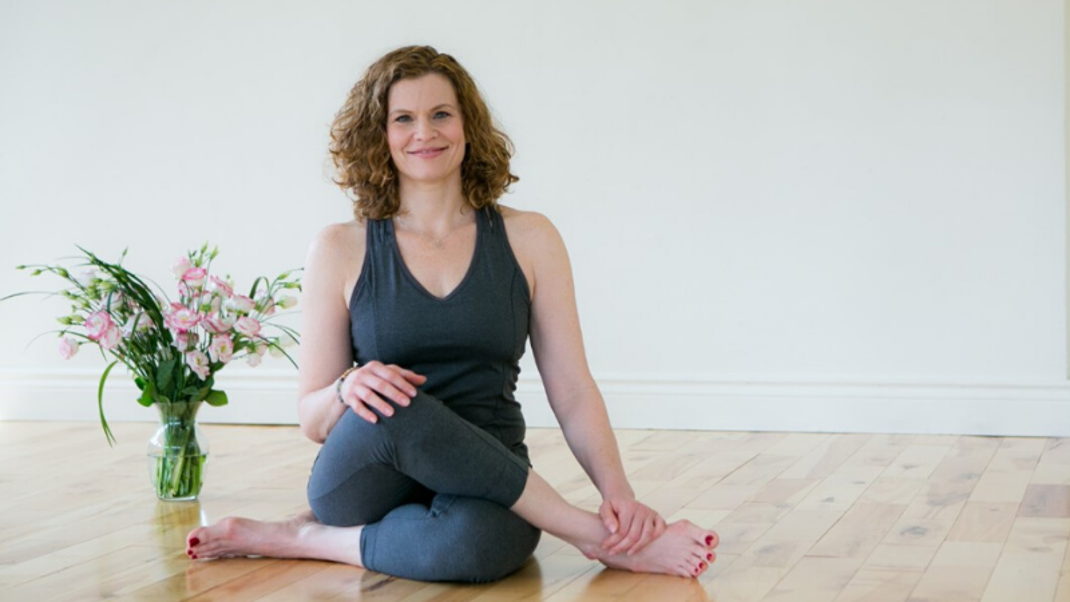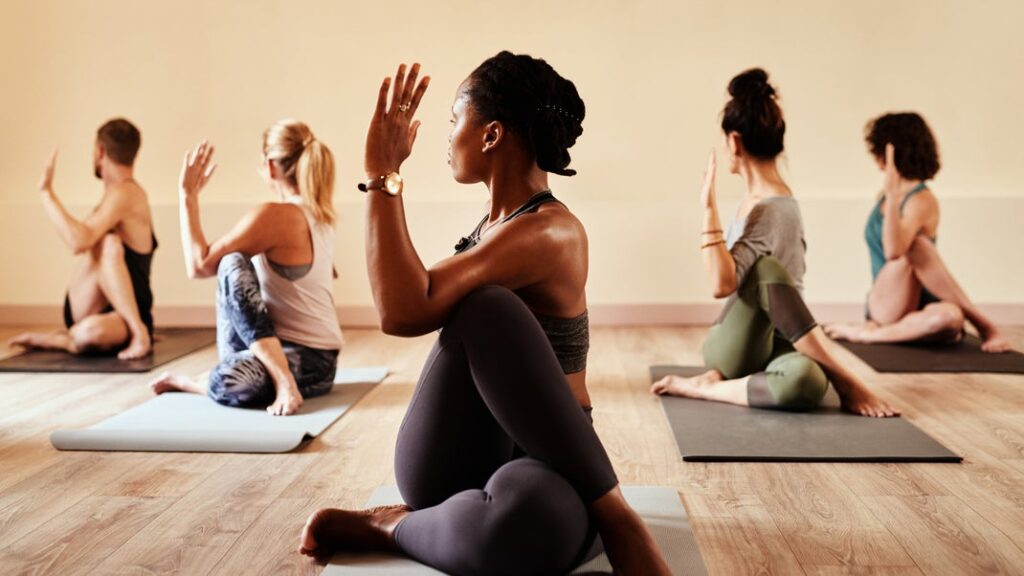Self-promotion can be a tough nut to crack. Yoga teachers often feel conflicted about it – they know that marketing is an important part of their job, but the idea of self-promoting makes them cringe.
Yoga teacher and author Emily Fletcher found herself in this position for many years before she realized there were ways to promote herself without feeling uncomfortable or insincere. In this article, we’ll discuss how you too can learn from her experience and use self-promotion as a tool for success!
For a long time, I was content to be anonymous as a yoga teacher. In 2015, despite teaching for nearly two decades and co-owning a reputable studio in Montreal for five years, I was comfortable hiding behind my studio brand. It was easy to pour my energy into building up our faculty and training in email newsletters, social media posts, and flyers around the neighborhood. But talking up myself as a teacher? Yikes—that was too scary and vulnerable.
As a result, my personal impact remained limited. I watched other teachers with less training, experience, and skill become Lululemon ambassadors, headline large festivals, and benefit from the platforms all of these opportunities afforded. On social media, I scrolled through photos of bikini-clad yoga teachers in Hanumanasana straddling boulders, or charismatic rockstar instructors miked up onstage leading stadium-like crowds through Sun Salutations. I felt insignificant as if I couldn’t measure up, even if I tried.
I didn’t necessarily want what they had, but I couldn’t deny that I yearned to grow as a teacher. However, the idea of marketing myself felt icky, not to mention downright un-yogic. I believed I would seem egotistical, desperate, or worse yet only interested in numbers and money.
Yet there were other reasons for my resistance: Insecurity and fear. (Perhaps you’re acquainted?) It didn’t matter that students told me I was among the most knowledgeable, skilled teacher in the city or that I had created the area’s first specialized therapeutic yoga and yoga for fertility programs. It didn’t matter that I had taught Sophie Gregoire Trudeau for years before she’d become Canada’s First Lady and that she’d graduated from my teacher training program. No matter how many international trainings I was invited to lead by colleagues in Europe, a dubious inner voice persisted. “Who am I to tell people I have something to offer?”
Evolving My Mindset on Marketing
The impulse to share my work emerged through writing. In 2016, I sold my studio and relocated from Montreal to Quebec’s bucolic countryside. I focused on writing and self-publishing my book, Evolving Your Yoga. As my book neared completion, I knew that becoming a published author would propel me “out there,” starting with the book tour I’d organize myself. As I considered this, a familiar deep-seated discomfort arose. This time, I couldn’t hide behind a studio. I needed to make peace with promoting my work.
Part of my resistance to marketing reflected a fundamental value I’m proud of: My teaching isn’t about me. It’s about serving my students. My teaching is more of a whisper than a scream. I want students, over time, to become independent in their practices, tap into their own inner voices, and learn to trust their own experiences as sources of guidance. This seemed in direct conflict with self-promotion’s goal of increasing my demand.
I decided to approach my marketing struggle the same way I approach my yoga practice—as a student. I sought out a business coach and mentor who works exclusively with women entrepreneurs. After a few weeks, she said something that flicked a switch in my brain: Sharing my perspective on yoga and who I was as a teacher wasn’t self-aggrandizing; it was an act of generosity.
Marketing my work didn’t have to come from a place of ego, desperation, or neediness. It was about making my offering visible to those it could benefit. After all, if no one knew me, how could I serve? At that point, the energy of marketing shifted from one of selling to one of sharing and serving, which felt easy and natural for me to embrace.
But I had some work to do.
Finding My Unique Voice as a Yoga Teacher
I decided to start my very first online group mentoring program for yoga teachers. But before I invited my former trainees, I defined what I was most excited about as a teacher. I clarified what I felt was most important to help them integrate all they received in training.
Once my purpose and passion became clear, I decided to write about them in a daily blog and share it with my mailing list and social followers that I’d gradually built up after I sold my studio. (I preferred Facebook. Focusing on writing and the resulting conversations—rather than photos—aligned better with my wish to delve deeper into practice.)
Through my writing, I discovered that my voice was valuable and unique. For me, yoga has been a lifelong path of learning and practice. I’d meditated regularly since 1993 and spent seven years immersed in traditional practice and scriptural study.
I drew on this as I wrote about my interest in asana, not only as a physical discipline but as part of an integrated stream of practices within the larger context of the yoga tradition. I talked about the rigor and richness of having a regular personal practice. I embraced yoga as a path of studentship rather than a consumer. I explored the depth of yogic texts and contemplative inquiry.
I kept writing, and practitioners noticed. Those who felt the same way commented that they, too, were committed to integrated experiences of yoga. This started meaningful interactions that allowed me to further connect with readers. By the time I started sharing details about my upcoming online programs, they signed up because they resonated with my approach and trusted that I could help them go deeper in their practices.
Now, four years later, I’ve built a thriving online community of teachers and students around the world. Last year, when I embarked on my self-planned book tour, it was a delight to meet students in Vancouver, New York, London, and Milan for readings and classes. I’d never felt so at ease inviting students to an event for me.
The Power of You: 5 Exercises for Authentic & Powerful Promotions
Every yoga teacher can learn to promote herself authentically. I believe that each of us has something special to offer. Why? Each of us comes to the mat with a unique set of skills, circumstances, and challenges. When we stand in our own experiences and articulate our passions and purposes, we discover what we bring to our teaching that’s uniquely ours. We serve the people we’re meant to serve and carve out the niche we’re meant to inhabit. I also understand that it takes time and courage to develop that marketing muscle in a way that feels genuine. Here, five simple and actionable ways to discover (and unleash) your unique gifts:
1. Tell Your Story
Your story is yours and yours alone. We all have one. Look back on your yoga journey and identify the significant experiences you’ve gathered over the years—the watershed moments, memorable teachers and training, and gems of wisdom. Recognize that these meaningful experiences made you the yoga teacher you are today. What do you want your students to know about the shifts that yoga has created in your life? What’s important for them to know about your unique journey?
Action: Make a timeline of your yoga journey as a student and teacher. Identify the significant turning points and watershed experiences that made you who you are as a practitioner and a teacher. Write about each one separately in a series of essays. Share them as blog posts or a series of Instagram posts.
2. Write a Love Letter
What can students expect from your classes? What do you expect from them? Create an authentic connection with your students by writing them an adoring letter clearly letting them know what happens in the classroom space with you.
Action: Hang it in the space where you teach to set the tone for your classes when your students arrive and as a reminder when they leave. If you’re teaching classes online, send it to them prior to class or in your thank you message. Publish it on your website.
3. Name & Claim Your Brand of Yoga
Go beyond hot, Yin, power, restorative, accessible, and all the other standard titles. Aside from the style you teach, what do YOU bring to your classes? What do you do that’s unique, personal, and different?
I call the style of yoga I teach Alignment-Based, Heart-Centered Hatha Yoga to reflect the spirit of yoga philosophy that infuses and contextualizes my technical approach to asana instruction.
If you aren’t sure what qualities you’re known for as a teacher, ask your students to tell you—and trust what they say. This is how I got comfortable embracing qualities like “well-respected, unpretentious, clear, and knowledgeable” to define my teaching style.
Action: Add this to your bio to stand out from the crowd and formulate a tagline that encapsulates your hallmark approach.
4. Define Your Matside Manner
Aside from what you do on the mat and in the classroom, what are the values you want to be known for as a teacher? Do you want to be generous, sensitive, and caring? Professional and organized? Responsive? Casual? Prepared? Be intentional.
Action: Write a list of your core values and post it in your workspace as a visible reminder of what you stand for. Make sure all your business decisions reflect your values.
There are a lot of ways to share a series of blog or social posts that represent your values: Inspirational quotes or poetry that speak to each value you stand for; nature photographs or artwork that sparks a contemplation on a particular value; or even write a story about the significance of each value.
5. Welcome New Practitioners
If you were the only exposure to yoga someone had, what would you tell them? What would you want them to know? As you get busier, you may forget that ushering people into the practice is a responsibility you bear.
Not only are beginning practitioners essential to a thriving student base, skillfully welcoming new students into the practice can create loyalty for a lifetime. Revisit your own start in yoga. What brought you there? What kept you coming back? What were the things you needed to hear? What encouragement helped you when yoga felt hard?
Conclusion:
Yoga is about finding answers for ourselves. Yoga philosophy can help us understand that our worth isn’t based on others perceptions of us but rather it comes from within, and when we stop expecting so much out of ourselves in order to bring value to the world around us, only then do we find true peace with our place in this big wide yoga community.




